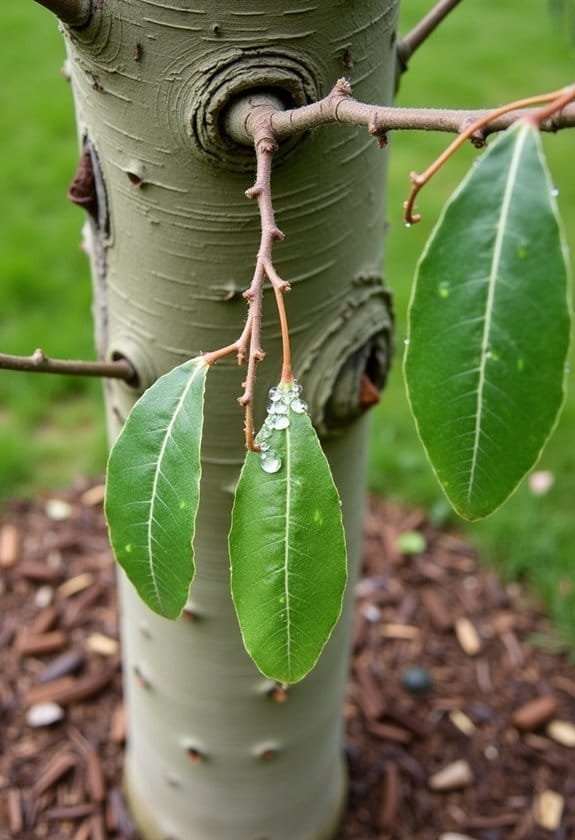Goat willow (Salix caprea) is a remarkable deciduous tree that's native to Europe and Asia, reaching heights of 8-10 meters at maturity. It's distinguished by its broad leaves and early spring catkins, with male trees producing vibrant yellow flowers and females displaying pale green ones. The species serves as a cornerstone for local biodiversity, supporting numerous pollinators and providing essential habitat for various moth species. As a dioecious plant, it requires both male and female specimens for successful reproduction, thriving in moisture-rich environments with well-draining soil. This versatile tree's extensive ecological contributions make it an intriguing subject for those interested in native woodland species.
Main Points
- Goat Willow is a fast-growing deciduous tree reaching heights of 8-10 meters, with distinctive male yellow catkins and female green flowers.
- Also known as pussy willow, this dioecious species flowers in early spring before leaf emergence, providing vital resources for pollinators.
- The tree thrives in diverse environments, preferring well-draining soils and requiring at least six hours of direct sunlight daily.
- Salix caprea supports local biodiversity by providing habitat for various wildlife, particularly moth species and their caterpillars.
- Regular pruning every 3-5 years maintains health, while monitoring for common issues like aphids, powdery mildew, and willow anthracnose is essential.
Introduction

Goat willow (Salix caprea), a resilient member of the willow family, stands as a remarkable deciduous tree that can flourish for up to three centuries in diverse habitats across Europe and Asia.
Its presence in both wetland margins and well-drained soils showcases its adaptability, while its distinctive oval leaves and seasonal catkins make it easily recognizable among its botanical relatives.
The species serves as a crucial ecological cornerstone, providing essential early-season pollen and nectar for pollinators, which has earned it significance in both natural landscapes and conservation efforts.
Common Name
Known by several common names, Salix caprea is widely recognized as goat willow, pussy willow, or great sallow. These diverse names reflect the plant's historical significance and distinctive characteristics across different cultural contexts and time periods.
The name "goat willow" has particularly deep historical roots, originating from the plant's traditional use as a nutritious browse for domesticated goats. This connection is further reinforced in the species' scientific nomenclature, where the Latin specific epithet "caprea" directly translates to "goat," emphasizing the long-standing relationship between the plant and these herbivorous mammals.
The first documented illustration of this notable willow species appeared in Hieronymus Bock's groundbreaking 1546 "Herbal," establishing its early recognition in formal botanical literature.
While "pussy willow" refers to its distinctive male catkins, which emerge as soft, silvery buds before transforming into vibrant yellow flowers in early spring, the term "great sallow" acknowledges its impressive size compared to other willow species in its native range.
Scientific Name
The scientific classification Salix caprea firmly establishes this species within the Salicaceae family, where it joins over 400 other willow species worldwide. The species name carries significant historical meaning, as "caprea" derives from the Latin word for goat, reflecting these animals' known preference for browsing on its foliage and tender branches throughout history.
Within the genus Salix, this species stands out for its distinctive dioecious nature, meaning individual plants are either male or female. This characteristic manifests most prominently during the flowering season, when male trees produce vibrant yellow catkins while female specimens display more subdued, pale green flowering structures.
The binomial nomenclature Salix caprea precisely identifies this remarkable species, which can grow to impressive heights of 10 meters and sustain life for more than three centuries. Its scientific classification also helps distinguish it from other willow species, particularly in identifying its adaptive capacity to thrive in various moisture conditions, from saturated riverbanks to relatively dry woodland margins.
Overview
Among Europe's native willows, Salix caprea stands as a remarkably versatile species, flourishing both as a shrub and small tree across diverse habitats. This resilient plant, commonly known as goat willow, can reach impressive heights of up to 10 meters and demonstrates exceptional longevity, with specimens often surviving for three centuries.
The goat willow's most distinctive feature emerges in early spring when it produces striking catkins, which serve as essential early-season resources for pollinators. Its dioecious nature, characterized by separate male and female plants, creates a fascinating reproductive dynamic, with male plants displaying vibrant yellow catkins while female plants produce more subtle, pale green varieties.
This adaptable species demonstrates remarkable versatility in its growing requirements, thriving particularly well in moisture-rich, poorly drained environments while maintaining the ability to establish itself in drier conditions.
Beyond its ornamental value, the goat willow plays an important ecological role by supporting diverse wildlife populations, particularly serving as a host plant for numerous caterpillar species and providing essential early-season sustenance for pollinating insects.
Key Features
The goat willow stands as a remarkable deciduous tree, reaching impressive heights of up to 10 meters with a potential lifespan of three centuries.
Its distinctive grey-brown bark develops diamond-shaped fissures as it matures, while its oval leaves, measuring 3-12 cm in length, showcase characteristic fine grey hairs on their undersides.
The tree's dioecious nature becomes evident in early spring when it produces gender-specific catkins, with male flowers displaying vibrant yellow hues and female catkins emerging in subtle pale green, both spanning 3-7 cm in length.
Growth Size
Growing rapidly throughout its development, goat willow (Salix caprea) reaches impressive heights of up to 10 meters (33 feet) with a spread of 12-15 feet at maturity. This vigorous small tree demonstrates remarkable growth velocity, typically achieving heights of 15-25 feet during its developmental stages, making it a notable presence in its environment.
The tree's physical structure is characterized by its broad, elliptical foliage, with individual leaves spanning 3-12 centimeters in length and 2-8 centimeters in width. During early spring, male specimens produce striking catkins measuring 3-7 centimeters, which mature into vibrant yellow displays before the leaves emerge.
As goat willow establishes itself, its root system develops in a distinctive pattern, remaining mainly shallow throughout its lifespan. This characteristic growth pattern, while beneficial for rapid establishment, requires careful consideration when planting near structures or hardscaping.
The tree's surface roots, which become more pronounced with age, can potentially interact with nearby infrastructure, making thoughtful placement essential for successful long-term growth.
Appearance
Distinctive features of goat willow make it instantly recognizable in any landscape. The tree's most notable characteristic is its oval-shaped foliage, which displays a striking contrast between dark green upper surfaces and silvery-grey undersides covered in fine, delicate hairs. These leaves, ranging from 3-12 centimeters in length and 2-8 centimeters in width, create a shimmering effect when stirred by the wind.
The tree's bark develops a distinctive personality as it matures, transforming into a grey-brown canvas marked by diamond-shaped fissures that create an intricate pattern across its surface.
In early spring, when goat willow is susceptible to increased pollinator activity, it produces remarkable catkins that serve as visual markers of the species. The male catkins mature into vibrant yellow clusters measuring 3-7 centimeters, while their female counterparts maintain a subtle pale green hue.
The fruiting stage introduces small capsules, 5-10 millimeters in size, which eventually release tiny seeds wrapped in cottony fibers that float through the air like miniature parachutes.
Flowering Season
During early spring, goat willow bursts into life with its spectacular flowering display, producing catkins before its leaves emerge. The plant's dioecious nature creates a fascinating distinction between male and female specimens, with male catkins developing into striking yellow blooms that stretch 3-7 centimeters in length.
These early-season flowers serve a vital ecological purpose, providing essential sustenance for emerging pollinators when few other nectar sources are available. The male catkins, resembling fuzzy golden fingers reaching toward the sky, transform from silver-gray buds into vibrant yellow beacons that attract numerous insect species, particularly bees seeking early spring nourishment.
The flowering process thrives in locations that receive ample sunlight, while adequate moisture levels guarantee ideal catkin development and longevity. This timing is perfectly orchestrated to support various wildlife, including numerous species of caterpillars that depend on the goat willow's seasonal progression.
Female plants contribute to this ecological symphony with their subtle green catkins, though it's the male specimens that typically draw the most attention with their showy yellow displays.
Growing Requirements

Goat willow's growing requirements center on its need for abundant sunlight, with a minimum of six hours of direct light daily, though it shows remarkable adaptability to partially shaded locations.
The species flourishes in moist, well-draining soils along waterways and can withstand periodic flooding, making it an excellent choice for riparian environments.
Its hardiness across USDA zones 4-8 allows it to endure both frigid winters and temperate summers, while its shallow root system demands careful consideration of planting location to accommodate future growth.
Light
Under ideal growing conditions, goat willow thrives in full sun, requiring a minimum of 6 hours of direct sunlight each day. This robust species harnesses solar energy most effectively when positioned in locations that receive abundant natural illumination throughout the growing season, promoting vigorous growth and optimal development.
While goat willow demonstrates some adaptability to partial shade conditions, its growth rate and overall vitality may be considerably diminished in areas with reduced light exposure. The plant's photosynthetic capabilities are particularly essential during its establishment phase, when adequate light helps develop strong root systems and healthy branch structures.
In container cultivation, proper light management becomes even more important, as potted specimens must maximize their limited growing space through efficient light utilization.
For gardeners in USDA zones 4-8, selecting an appropriate planting location that balances light requirements with local climate conditions is fundamental. The interplay between sunlight exposure and moisture availability plays a key role in the success of goat willow specimens, making strategic placement in well-lit areas a key consideration for optimal growth outcomes.
Soil
A well-prepared soil foundation complements the light requirements of goat willow, creating ideal conditions for robust growth. This adaptable species demonstrates remarkable versatility in its soil preferences, thriving in both moisture-rich and well-draining environments that support its extensive root system.
While goat willow exhibits impressive tolerance for varying soil conditions, proper moisture management remains essential for peak development. The addition of mulch serves as a protective barrier, helping maintain consistent soil moisture levels and reducing environmental stress during dry periods. This natural insulation becomes particularly beneficial as the plant establishes its characteristically shallow root system.
Special consideration must be given to the soil preparation when cultivating container specimens, as potted goat willows require more frequent attention to moisture levels than their ground-planted counterparts.
The shallow-rooting nature of this species necessitates careful placement planning, as mature specimens can develop extensive surface roots that may interfere with nearby structures or underground utilities. Regular soil moisture monitoring, combined with appropriate spacing, guarantees the plant maintains its vigor while coexisting harmoniously with its surroundings.
Water
Maintaining proper water levels plays an essential role in the successful cultivation of goat willow. These adaptable trees demonstrate a natural affinity for moisture-rich environments, particularly thriving along riverbanks and lake shores where water is abundant. While they excel in wet conditions, maintaining a delicate balance between adequate moisture and overwatering is vital for peak growth.
For container-grown specimens, regular watering becomes even more important, as potted environments can quickly dry out compared to natural settings. A well-formulated potting mix that combines commercial components with moisture-retaining compost helps regulate water distribution throughout the root system.
When establishing new plantings, careful consideration must be given to the proximity of water lines and utilities, as the tree's vigorous root system actively seeks out moisture sources. While goat willow can tolerate periods of partial shade, providing adequate sunlight alongside proper hydration guarantees robust growth and flowering.
Gardeners should monitor soil moisture regularly, particularly during dry spells, while remaining vigilant against overwatering, which can compromise root health and lead to fungal complications.
Temperature
Temperature requirements for goat willow reflect its remarkable adaptability across diverse climate zones. Native to Europe, this resilient tree or large shrub thrives in USDA hardiness zones 4-8, demonstrating exceptional tolerance for both cold winters and mild summers.
The species' robust nature allows both male and female plants to flourish in varied thermal conditions typical of its extensive natural range.
In early spring, when temperatures begin to moderate, goat willow showcases its reproductive capabilities with distinctive flowers. Female flowers emerge as temperatures rise, following a period of winter dormancy that's essential for the plant's natural growth cycle.
The species' temperature adaptability is particularly evident in regions like Northern Illinois, where it withstands seasonal extremes without requiring special protection. This European native maintains healthy growth patterns in climates experiencing winter temperatures as low as -30°F (-34°C), while also tolerating summer heat up to 90°F (32°C).
Its temperature resilience, combined with proper sun exposure of at least six hours daily, enables the goat willow to establish itself as a hardy and reliable landscape specimen.
Pollinator Criteria
Goat willow serves as a crucial early-season beacon for pollinators, with its bright yellow male catkins attracting numerous bee species as they emerge from winter dormancy.
The tree's dioecious nature, requiring separate male and female plants, creates an intricate pollination network that sustains robust pollinator populations throughout the growing season.
Beyond direct nectar and pollen provision, goat willow supports multiple moth species whose caterpillars feed on its foliage, establishing a complex ecological web that strengthens local pollinator communities.
Attracted Pollinators
Early spring catkins make the goat willow a crucial resource for pollinators, particularly bees and other insects seeking nectar and pollen during their active season. The pussy willow's male catkins transform into striking yellow beacons that signal their readiness to visiting pollinators, offering an essential food source when many other plants remain dormant.
The dioecious nature of goat willow, requiring separate male and female plants, creates a dynamic ecosystem that supports a diverse range of pollinator species. These industrious visitors, including various bee species and early-emerging insects, transfer pollen between plants, ensuring successful reproduction and maintaining healthy populations.
The relationship extends beyond simple pollination, as numerous Lepidoptera species depend on the willow's foliage for sustenance during their larval stages. This intricate web of interactions demonstrates how goat willow serves as a cornerstone species in supporting local biodiversity.
The presence of these trees in an ecosystem creates a cascade effect, attracting and sustaining multiple pollinator species that, in turn, contribute to the overall health and resilience of the surrounding environment.
Pollination Method
Through its dioecious reproduction system, Salix caprea relies on both wind and insect pollination to guarantee successful fertilization between separate male and female plants. The male plants produce distinctive yellow catkins that emerge in early spring, releasing copious amounts of lightweight pollen into the air.
The strategic timing of this pollination process is particularly remarkable, as the catkins appear before most trees have developed their leaves, creating ideal conditions for wind-borne pollen distribution.
Female plants, distinguished by their pale green catkins, stand ready to receive this airborne pollen, while their positioning within the landscape greatly influences pollination success rates. The dual pollination strategy proves highly effective, as wind carries pollen over longer distances, while bees and other insects facilitate more targeted delivery between neighboring plants.
For successful reproduction to occur, male and female goat willows must grow within reasonable proximity to one another, typically within several hundred meters.
This spatial requirement highlights the importance of maintaining diverse willow populations in natural environments, where both sexes can thrive and support continued species propagation.
Care & Maintenance

Successful cultivation of goat willow starts with selecting a sunny location and preparing well-draining soil that can accommodate its extensive surface root system.
The shallow-rooted nature of this plant means gardeners should maintain consistent moisture levels through mulching, while implementing a regular pruning schedule every 3-5 years to manage its vigorous growth pattern.
Companion planting with moisture-loving perennials and spacing the willow at least 15 feet from structures helps create an ideal growing environment while minimizing potential conflicts with nearby infrastructure.
Planting Tips
When planting goat willow, select a location with full sun exposure that provides at least 6 hours of direct sunlight daily. This European native thrives in moist and well-drained soil conditions, making it adaptable to both wet and dry environments, though it shows a clear preference for moisture-retentive locations.
Consider the tree's shallow root system when choosing a planting site, as mature specimens can develop extensive surface roots that might interfere with nearby infrastructure. It's important to position the tree at least 20 feet away from water lines, foundations, and other underground utilities.
The weeping form of goat willow requires particular attention to spacing, as its cascading branches need room to develop their characteristic shape. While both male and female plants produce attractive catkins, they'll need proper pruning every 3-5 years to maintain their aesthetic appeal and promote robust growth.
Regular monitoring for common pests like aphids and diseases such as powdery mildew guarantees the tree's long-term health, with early intervention using appropriate treatments being key to successful management.
Ongoing Care
Maintaining a goat willow's health and significance requires consistent attention to several key aspects of care. Regular monitoring for common pests like aphids and diseases such as powdery mildew is crucial, with horticultural oil serving as an effective treatment for infestations when they arise.
To guarantee peak growth, prune goat willow every 3-5 years during late winter to early spring, just before new growth emerges. This timing allows the tree to direct its energy into fresh development while maintaining its desired shape and size.
The plant thrives when receiving at least six hours of direct sunlight daily, coupled with consistent moisture in well-draining soil conditions. Given the tree's shallow root system, careful consideration must be given to its placement, as surface roots may eventually impact nearby structures or underground utilities.
For sustained health, implement a regular watering schedule, paying particular attention to container-grown specimens that require more frequent hydration. Additionally, an annual application of fertilizer in spring supports robust growth and flowering, guaranteeing the tree's continued health throughout the growing season.
Suggested Companions
Several companion plants thrive alongside goat willow while enhancing its natural habitat value. The willow species pairs exceptionally well with moisture-loving wetland plants, particularly marsh marigold and blue flag iris, creating a dynamic ecosystem that supports local biodiversity.
For maximum visual impact, integrating dogwood shrubs near goat willow creates stunning seasonal displays through contrasting foliage and blooming periods.
When planning companion plantings, it's crucial to take into account the spacing requirements that promote adequate air circulation, helping prevent common issues like fungal diseases and pest infestations that can affect the entire planting group.
The key to successful companion planting lies in matching the cultural requirements of all selected species. Since goat willow requires at least six hours of direct sunlight daily, chosen companions must share similar light preferences.
Additionally, the soil should remain consistently moist yet well-draining to accommodate both the willow and its neighboring plants. Regular pruning of goat willow every 3-5 years guarantees it doesn't overwhelm its companions, maintaining a harmonious balance within the planted area.
Are There Similar Growing Conditions for Sweet Woodruff and Goat Willow?
Sweet woodruff and goat willow thrive in partially shaded, moist environments, making them suitable companions in a garden. The sweet woodruff plant uses and benefits range from natural ground cover to fragrant bouquets, while goat willow is appreciated for its ornamental value and wildlife support, creating a harmonious and functional outdoor space.
Common Issues
Goat willow faces several significant health challenges, including powdery mildew, twig blight, and the particularly aggressive willow anthracnose, which can severely compromise the tree's robustness.
Common insect threats include sap-feeding aphids and leaf-munching caterpillars, which can be effectively managed through targeted applications of horticultural oil or forceful water sprays.
The tree's structural integrity often comes under attack from these pests and diseases, making regular monitoring and prompt treatment essential for maintaining its health and preventing the spread of infections to neighboring plants.
Pests/Diseases
While generally hardy, goat willow faces several considerable health challenges that can impact its growth and survival. Among the most troublesome pests are aphids and caterpillars, which can be effectively managed through targeted applications of hard water sprays or horticultural oils to maintain the plant's vitality.
The tree is particularly vulnerable to several fungal diseases that can compromise its health. Powdery mildew, appearing as a white, dusty coating on leaves and stems, thrives in humid conditions and can greatly impair photosynthesis.
Twig blight poses another serious threat, causing dieback in new growth areas, especially when the plant experiences moisture stress or physical damage. Leaf spot diseases manifest as dark lesions across the foliage, gradually diminishing the tree's vigor and aesthetic value.
Perhaps most concerning is willow anthracnose, a devastating condition that can lead to extensive defoliation and distorted growth patterns. Managing these diseases typically requires a combination of cultural practices, including proper pruning of infected branches and maintaining adequate air circulation around the plant.
Solutions
Common issues affecting goat willow can be effectively managed through targeted solutions and preventive measures. Regular monitoring and swift action are essential components of maintaining a healthy tree, particularly when dealing with fungal diseases and pest infestations.
For disease management, proper sanitation practices play a critical role in controlling powdery mildew, twig blight, and leaf spot. The immediate removal of affected branches helps prevent the spread of willow anthracnose, which could otherwise lead to severe defoliation throughout the tree.
When dealing with pest problems such as aphids and caterpillars, implementing mechanical controls like hard water sprays or applying horticultural oil provides effective relief without harsh chemicals.
To address structural concerns, especially regarding the tree's shallow root system, careful planning during planting is essential. Maintaining an appropriate distance from underground utilities prevents future complications, while implementing a regular pruning schedule every 3-5 years helps maintain the tree's size and stability.
This proactive approach greatly reduces the risk of damage from heavy snow or ice, ensuring the long-term health and well-being of the goat willow.
Summary

The versatile Salix caprea, widely known as Goat Willow, stands as a resilient deciduous tree that can live up to three centuries. This remarkable species showcases its distinctive reproductive features through its early spring catkins, with male specimens producing vibrant yellow blooms while female catkins display a subtle pale green hue.
Reaching heights of 8-10 meters, this adaptable tree demonstrates impressive environmental flexibility, flourishing in both moisture-rich and relatively dry conditions. Its ecological significance extends far beyond its physical presence, as it serves as a essential early-season resource for numerous pollinators and sustains various wildlife species throughout its lifecycle.
The dioecious nature of Goat Willow necessitates the presence of both male and female plants for successful reproduction, highlighting the significance of maintaining diverse populations. While facing challenges such as watermark disease, this species continues to play a critical role in supporting local biodiversity through its provision of food and habitat for countless organisms, from tiny caterpillars to foraging birds, making it an invaluable component of woodland and scrub ecosystems.


